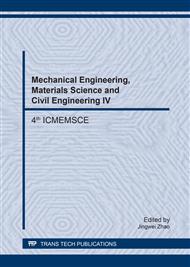[1]
W.V. Swain, The structure and properties of ceramic, J. Materials Science and Technology Series. (1998) 93-94.
Google Scholar
[2]
R. Weng, Advanced structural ceramic materials, N. China Mining News. (2002) 003.
Google Scholar
[3]
Z. H Lin, Application technology, status quo and development of zirconia materials in structural ceramics, Rare Metal Express. (2004) 6-10.
Google Scholar
[4]
H. S Xu, New Applications of zirconia materials, J. Science and Technology. 26(2) (2007) 30.
Google Scholar
[5]
W. Y Zhen et al, Properties, application and development direction of zirconia, J. Inorganic salt industry. 32(1) (2000) 18-20.
Google Scholar
[6]
L.B. Ha, H.L. Kwang, Manufacture of black zircon ceramics used for e. g. semiconductor chip, involves granulating and molding zirconia powder, placing obtained molded product in graphite crucible filled with graphite and sintering molded product, P. KR. Patent. 2, 010, 137, 299. (2010).
Google Scholar
[7]
W.J. Si, Y. Wu, Manufacturing black zirconia ceramic at low temperature comprises synthesizing nanometer colorant, synthesizing nanometer zirconia powder with coprecipitation process , and applying iron-cobalt-nickel-manganese composite as the colorant . P. CN. Patent. 101, 704, 671. (2010).
Google Scholar
[8]
R. Stevens, Zirconia and Zirconia Ceramics. Magnesium Elektron Ltd. (1986).
Google Scholar
[9]
N. Claussen, Strengthening strategies for ZrO2-toughened ceramics at high temperatures. Mater. Sci. Eng. 71 (1985) 21-38.
DOI: 10.1016/0025-5416(85)90203-4
Google Scholar
[10]
G.Y. Jr. Onoda, L.L. Hench, eds Ceramic Processing Before firing,. Wiley - Interscience. (1978).
Google Scholar
[11]
S. Guillement-Fritsch et al, Thermochemistry of iron manganese oxide spinels. Journal of Soild State Chemistry. 178 (2005) 106-113.
DOI: 10.1016/j.jssc.2004.10.031
Google Scholar
[12]
E. Ozel, S. Turan, Production of colored zircon pigments from zirconia, J. Journal of the European Ceramic Society. 2 (2007) 179-184.
Google Scholar
[13]
P.M. Winkler et al, Heterogeneous nucleation experiments bridging the scale from molecular ion clusters to nanoparticles. Science. 319 (2008) 1374-1377.
DOI: 10.1126/science.1149034
Google Scholar
[14]
J.X. Zhang, L.Q. Gao, Nano composite powders from coating with heterogeneous nucleation processing, J. Ceram Int. 27 (2001) 143-147.
Google Scholar
[15]
M. Ocana et al, Preparation by hydrolysis of aerosols and colour properties of Cr-doped and Co-doped zircon powders, J. Eur. Ceram. Soc. 18 (1998) 821-830.
DOI: 10.1016/s0955-2219(97)00208-2
Google Scholar
[16]
M. Lusar et al, Environmental optimization of blue vanadium zircon ceramic pigment, J. Eur. Ceram. Soc. 19 (1999) 2647-2657.
Google Scholar
[17]
N. Claussen, Strengthening strategies for ZrO2-toughened ceramics at high temperatures. Mater. Sci. Eng. 71 (1985) 21-38.
DOI: 10.1016/0025-5416(85)90203-4
Google Scholar
[18]
R. Stevens, Zirconia and Zirconia Ceramics. Magnesium Elektron Ltd. (1986).
Google Scholar


